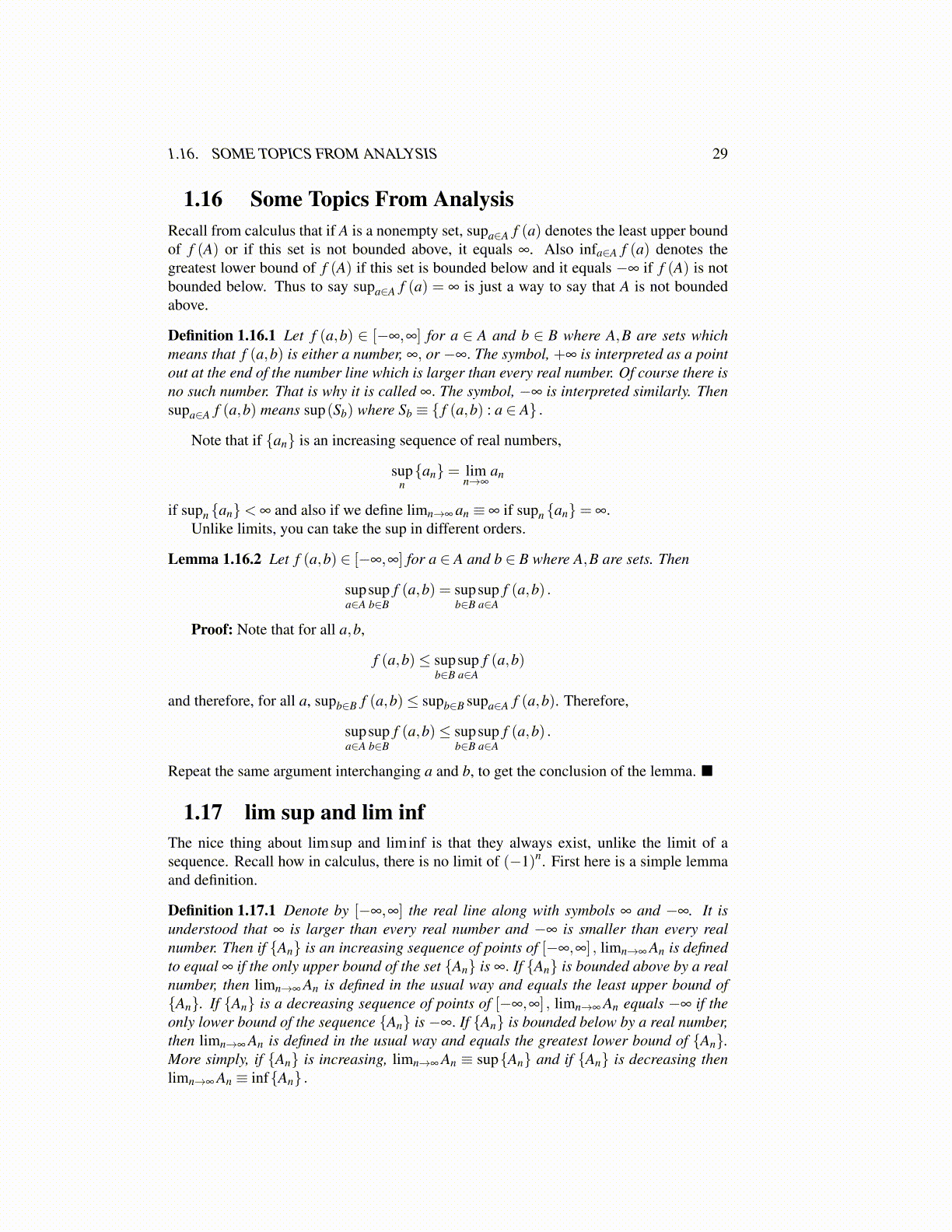
1.16. SOME TOPICS FROM ANALYSIS 29
1.16 Some Topics From AnalysisRecall from calculus that if A is a nonempty set, supa∈A f (a) denotes the least upper boundof f (A) or if this set is not bounded above, it equals ∞. Also infa∈A f (a) denotes thegreatest lower bound of f (A) if this set is bounded below and it equals −∞ if f (A) is notbounded below. Thus to say supa∈A f (a) = ∞ is just a way to say that A is not boundedabove.
Definition 1.16.1 Let f (a,b) ∈ [−∞,∞] for a ∈ A and b ∈ B where A,B are sets whichmeans that f (a,b) is either a number, ∞, or −∞. The symbol, +∞ is interpreted as a pointout at the end of the number line which is larger than every real number. Of course there isno such number. That is why it is called ∞. The symbol, −∞ is interpreted similarly. Thensupa∈A f (a,b) means sup(Sb) where Sb ≡ { f (a,b) : a ∈ A} .
Note that if {an} is an increasing sequence of real numbers,
supn{an}= lim
n→∞an
if supn {an}< ∞ and also if we define limn→∞ an ≡ ∞ if supn {an}= ∞.Unlike limits, you can take the sup in different orders.
Lemma 1.16.2 Let f (a,b) ∈ [−∞,∞] for a ∈ A and b ∈ B where A,B are sets. Then
supa∈A
supb∈B
f (a,b) = supb∈B
supa∈A
f (a,b) .
Proof: Note that for all a,b,
f (a,b)≤ supb∈B
supa∈A
f (a,b)
and therefore, for all a, supb∈B f (a,b)≤ supb∈B supa∈A f (a,b). Therefore,
supa∈A
supb∈B
f (a,b)≤ supb∈B
supa∈A
f (a,b) .
Repeat the same argument interchanging a and b, to get the conclusion of the lemma. ■
1.17 lim sup and lim infThe nice thing about limsup and liminf is that they always exist, unlike the limit of asequence. Recall how in calculus, there is no limit of (−1)n. First here is a simple lemmaand definition.
Definition 1.17.1 Denote by [−∞,∞] the real line along with symbols ∞ and −∞. It isunderstood that ∞ is larger than every real number and −∞ is smaller than every realnumber. Then if {An} is an increasing sequence of points of [−∞,∞] , limn→∞ An is definedto equal ∞ if the only upper bound of the set {An} is ∞. If {An} is bounded above by a realnumber, then limn→∞ An is defined in the usual way and equals the least upper bound of{An}. If {An} is a decreasing sequence of points of [−∞,∞] , limn→∞ An equals −∞ if theonly lower bound of the sequence {An} is −∞. If {An} is bounded below by a real number,then limn→∞ An is defined in the usual way and equals the greatest lower bound of {An}.More simply, if {An} is increasing, limn→∞ An ≡ sup{An} and if {An} is decreasing thenlimn→∞ An ≡ inf{An} .